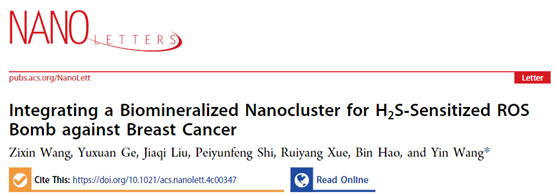
News & Events

News & Events
Recently, Prof. Yin Wang’s research group from School of Pharmaceutical Sciences at Shanghai Jiao Tong University published a paper titled Integrating a Biomineralized Nanocluster for H2S-Sensitized ROS Bomb against Breast Cancer in Nano Letters, a leading international journal in the nanotechnology field. The research reveals that combined therapy from gas therapy, chemodynamic therapy, and chemotherapy could be used as a powerful strategy to treat breast cancer. The first author is Zixin Wang, a PhD candidate, and the corresponding author is Prof. Yin Wang.

Breast cancer, a deadly disease with high morbidity rates in women, is primarily treated with surgery, chemotherapy, and radiotherapy. However, drug resistance and side effects seriously compromise the efficacy of these treatments. With the development of technology, chemodynamic therapy (CDT) that relies on a Fenton or Fenton-like reaction catalyzed by transition metal ions to convert hydrogen peroxide (H2O2) into hydroxyl radicals (·OH), has been proposed to treat such intractable disease. Nevertheless, the concentration of endogenous H2O2 is evidently insufficient for CDT to achieve the desired therapeutic efficacy. To address this issue and augment the therapeutic efficacy, the research team prepared a biodegradable nanocluster MnS@HA-DOX (MnS@HA-DOX NC) by in situ biomineralization from hyaluronic acid, to enlarge the ROS cascade and boost Mn2+-based CDT. The acid-responsive NCs could quickly degrade after internalization into endo/lysosomes, releasing Mn2+, H2S gas, and anticancer drug doxorubicin (DOX). The Fenton-like reaction catalyzed by Mn2+ was amplified by both H2S and DOX, producing a mass of cytotoxic ·OH radicals. Through the combined action of gas therapy, CDT, and chemotherapy, oxidative stress would be synergistically enhanced, inducing irreversible DNA damage and cell cycle arrest, eventually resulting in cancer cell apoptosis.

Schematic Illustration of the Preparation and Antitumor Mechanism of MnS@HA-DOX NCs
Paper link:https://pubs.acs.org/doi/full/10.1021/acs.nanolett.4c00347

SCHOOL OF PHARMACY,SJTU
Address: 800 Dongchuan Road, Shanghai
200240